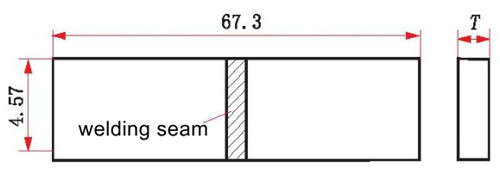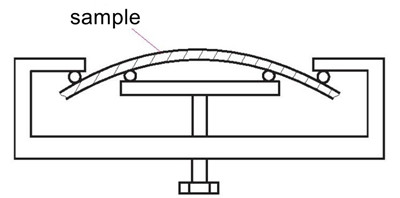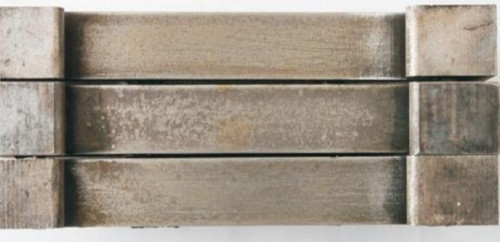To prevent electrochemical corrosion damage and high voltage corrosion cracking H 2 S/CO 2 Oil and gas pipelines were used to study the processing technology and corrosion resistance of N08825 nickel alloy composite pipes to be used in the raw pipeline of a natural gas processing plant. The results show that the mechanical properties and SCC properties of USA N08825 Nickel Alloy Composite Pipes meet the requirements of SEI “Specification for Welded Composite Steel Pipes and Fittings” of the Gas Purification Plant Pipeline Hidden Problems Control Project. Sinopec Puguang gas field. The results show that by controlling the processing technology of large diameter nickel alloy pipe fittings and applying a protective agent to the inner surface of the composite pipe, the molding quality of composite pipe fittings and the corrosion cracking resistance under voltage under high H can be improved 2 S/CO 2 environment can be guaranteed.
In recent years, with the growing demand for energy, energy problems have become an important constraint on the economic development of countries. With the continuous growth of demand for oil and natural gas, the exploration of oil and gas fields has shifted from the original production of crude oil to the production of fine oil, and the proportion of exploration of oil and gas fields with high S is also gradually increasing. At present, in the transmission of natural gas with high sulfur content (w(S)>17%) in composite pipelines used in the transportation process, the inner wall of the composite material (316L) is severely corroded, the service life is short , and there is a huge security risk. The industry urgently needs to resolve this issue.
For high H 2 S/CO 2 Oil and gas fields, H 2 S and CO 2 Coexistence of corrosive than the existence of a separate H 2 S more corrosive, avoid H 2 S/CO 2 caused by electrochemical corrosion damage and stress corrosion cracking, the usual answer is to use expensive stainless steel pipes. To ensure the corrosion resistance of the pipeline and keep costs under control, we can choose bimetallic composite pipes instead of stainless steel pipes. A nickel-based composite is one of the most representative materials. Nickel alloy N08825 is a titanium-stabilized, corrosion-resistant Ni-Fe-Cr-Mo alloy. This alloy has good corrosion resistance and machinability, but is also resistant to high temperatures. Due to its excellent resistance to sulfide and chloride corrosion, the alloy is widely used in the high sulfur crude oil processing industry for equipment or piping materials in hydrogenation plants where severe sulfide and chloride corrosion occurs. This study analyzes the processing technology and corrosion resistance of N08825 nickel-based alloy composite pipes for use in a natural gas processing plant raw gas pipeline safety risk management project.
The thermal processing of N08825 nickel alloy material has always been a metallurgical process and faces a difficult problem: difficulty in manufacturing the product; The main problem is the material's resistance to thermal deformation and the narrow temperature range in which thermoplastics can best be processed. The Q245R+N08825 nickel alloy pipe fittings used in this study for a natural gas processing plant are raw gas line pipes. The steel pipe is a rolled and then welded explosion composite steel plate, with a nominal diameter of DN700mm and a wall thickness of 36mm + 3.2mm.
Stress corrosion resistance is composed of N08825 nickel-based composite materials in high H 2 S/CO 2 Oil and gas field companies use an important performance indicator before heat treatment of composite pipes to protect the inner surface of the composite board. This means that the protective agent is evenly applied to the inner surface of the N08825 nickel-based alloy steel tube. Furthermore, to ensure high corrosion resistance of the inner surface of the composite layer, the tool mold design is optimized. The contact surface of molds and tool accessories is coated with a layer of stainless steel to prevent contamination by iron ions during the molding process. The mold surfaces are processed by CNC milling machines to ensure the dimensional accuracy and speed of the molding process after separating the molds and accessories.
In order to ensure that the composite pipe fittings have the corrosion resistance of the complex layer and the mechanical properties of the base layer after heating, the heating temperature (890 ± 15) ℃ is determined, this temperature range is on the basis of both Q245R normalization temperature range and stabilized temperature range The heat treatment of nickel alloys not only ensures the mechanical properties of the base layer, but also ensures the mechanical properties of the complex layer's corrosion resistance. The heat treatment holding time is 59 minutes (total wall thickness of basic metal material and connecting layer × 1.5). Retention time can not only ensure the solid solution effect of nickel-based alloys, but also reduce the negative effects of prolonged high temperature conditions on the overall performance of composite pipe fittings.
2. N08825 Nickel Alloy Composite Fittings with Mechanical Properties and SCC Performance Analysis
2.1 Mechanical properties of composite fittings made of nickel-based alloy N08825
Nickel-based alloy pipe fittings Q245R + N08825 basic metallic material Tensile strength tests are carried out on the external side of the Q245R arc (1# sample) and on the welded joints (2# sample); test results are listed in Table 1. Table 1 shows the test results to meet the tensile property requirements of the raw gas pipeline Sinopec Puguang Gas Field Cleaning Plant for safety and hidden issues of the SEI project “Specification for welded composite steel pipes, pipe fittings”. Furthermore, the tensile properties of the welded joints were analyzed. Furthermore, the welded joints were subjected to a flexural test on the d = 4a side; The test results are shown in Table 2, and the results also meet the standard requirements.
Table 1 Specifications of DN700 mm × (36 + 3.2) mm Mechanical properties of nickel-based composite pipe joints Q245R + N08825
| Sample number R eL /MPa | R M /MPa | A/% | Breaking point | Sample collection location | |
| 1 | 314 | 436 | 26 | Lateral direction of the outer arch side of the base layer | |
| two | 459 | Basic metal material | Base Layer Horizontal Weld Joint | ||
| Standard requirements | ≥ 235 | 400-520 (Base metal) ≥ 400 (Welded joint) | ≥ 25 | ||
Table 2: Weld Bending Test Results for Q245R+N08825 Nickel-Based Pipe Joints
| Sample number | Sample collection location | Test result |
| 3-1 | Welded connection | Qualified |
| 3-2 | Welded connection | P updated |
| 3-3 | Welded connection | Qualified |
| 3-4 | Welded connection | Qualified |
2.2 Stress corrosion cracking behavior of composite pipe fittings made of nickel-based alloy N08825
Several domestic oil and gas field development companies are located in the geological structure, which contains a large number of H 2 S and CO 2 Gas; Aqueous solutions of these two gases are highly corrosive and are not only prone to localized corrosion, but also lead to sulfide stress corrosion cracking, which seriously affects the safe use of the corresponding equipment.
According to the technical specifications and literature on natural gas purification plants with nickel-based composite pipe joints of composite welded joints for stress corrosion cracking test, the simulation of working conditions is shown in Table 3.
Table 3: Simulated working conditions
| Temperature/°C | Ph. 2 S/MPa | PCO2 / MPa | Initial pH value |
| 120 | 2.2 | 1.1 | 3.4 |
For the test, the perpendicular to the weld seam in the composite layer of the welded connecting parts was measured on three samples, with the sample size shown in Figure 1.

Figure 1 Schematic representation of sample size
After the samples were degreased with acetone and dehydrated with alcohol, they were loaded with a four-point bending device as shown in Figure 2. The load was 209.6 MPa. Three samples were placed in the autoclave for a 720-hour high-temperature stress corrosion cracking test.

Figure 2 Schematic representation of four-point bending sample loading
Figure 3 shows the macroscopic morphology of the three samples after 720 hours of high-temperature stress corrosion cracking testing. No cracks can be seen on the sample surface perpendicular to the direction of tensile stress on the sample surface, which meets the requirements of the technical specifications.

Figure 3 Macroscopic morphology of the surface of a weld sample after the stress corrosion test

























































